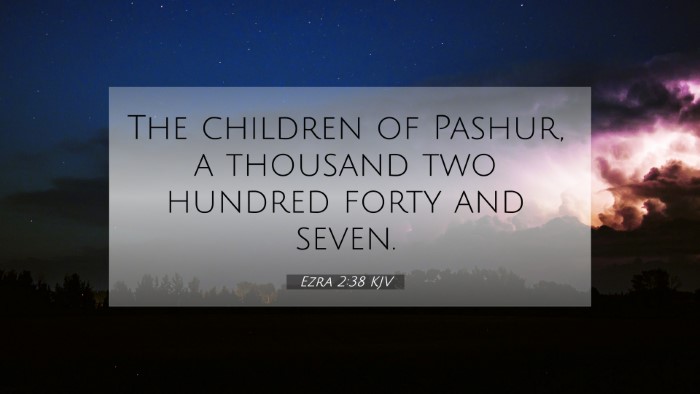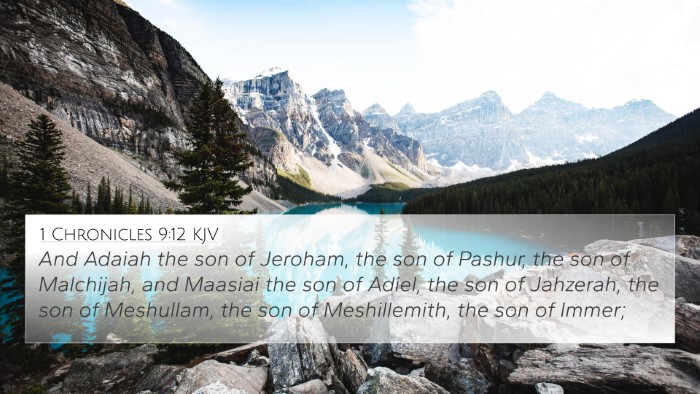Understanding Ezra 2:38
Contextual Overview: Ezra 2:38 lists the priests who returned from exile to Jerusalem. This verse contributes to a larger narrative where the exiles, upon their return, organized themselves according to their familial and tribal identities. The mention of the priests signifies the restoration of religious practices central to their community life.
Commentary Insights
- Matthew Henry: Henry emphasizes the significance of the priests' return, noting that their presence was essential for the reinstatement of the temple worship. The priests represented a link back to the spiritual heritage of Israel, restored after a period of exile and desolation.
- Albert Barnes: Barnes focuses on the organization of the returning exiles. He notes that the list of priests reflects God's faithfulness to maintain a remnant dedicated to His service. This element of divine faithfulness is meant to reassure the returning community of their rightful place in God's plan.
- Adam Clarke: Clarke highlights the importance of names and numbers in this passage. He indicates that such detailed records serve to validate the authenticity of the returning community. The mention of specific families and priests also reinforces the continuity of tradition despite their long absence from Jerusalem.
Bible Verse Cross-References
This verse finds connections in several other scripture passages that emphasize the role of priests and the significance of their lineage:
- 1 Chronicles 5:29: This verse discusses the lineage of Levi and highlights the importance of the priesthood.
- Exodus 28:1: God commands Moses to set apart Aaron and his sons as priests, establishing the foundational role of the priestly lineage.
- Nehemiah 12:1-26: A parallel passage that reinforces the listing and organization of priests and Levites, similar to Ezra 2.
- Hebrews 7:14: Discusses Jesus as a high priest in the order of Melchizedek, reflecting on the importance of a priestly lineage in relation to Jesus’ eternal priesthood.
- Jeremiah 33:21: God promises to maintain a descendant of David as ruler, paralleling the priestly aspect of continuity and restoration.
- Ezra 3:2-4: The return to Jerusalem and the laying of the foundation of the temple highlights the necessity of priestly action in worship and sacrifices.
- Matthew 2:4-6: This New Testament reference reveals the prophetic lineage and fulfillment concerning Jesus, linking to the expectations of a priestly role.
Thematic Connections and Analysis
This verse, while historical in nature, carries a rich thematic resonance that spans the entire biblical narrative:
- Priesthood and Worship: Ezra 2:38 highlights the fundamental role of the priesthood in Israelite worship, echoing themes seen throughout the Pentateuch and the New Testament.
- Restoration and Hope: The return of the exiles symbolizes the hope of renewal by God, a recurrent theme in both Old and New Testaments.
- Identity and Community: The careful recording of names signifies the importance of identity within the community of faith, resonating with other texts that emphasize God's people as a unified body.
Using Bible Cross-References
For those studying this verse, utilizing cross-references can enhance understanding. Here are some suggested methods:
- Bible Concordance: Use a Bible concordance to locate these references for deeper study.
- Bible Cross-Reference Guide: Employ a guide to find related passages that elaborate on themes of priesthood and community restoration.
- Cross-Referencing Bible Study: Engage in a systematic approach by comparing similar themes across different books to see how God’s plan unfolds.
Conclusion
Ezra 2:38 serves as a reminder of the importance of lineage, identity, and worship in the life of God’s people. By exploring this verse within the broader context of scripture, one can uncover the theological richness that underscores the continuity of God's covenant relationship with Israel. Utilizing tools for Bible cross-referencing not only enriches individual study but also enhances our communal understanding of God’s ongoing narrative throughout the scriptures.





